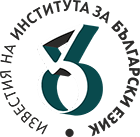Author Layout Style Guide
We accept for publication original scientific materials up to 90 standard (162 000 characters) type-written pages.
Fond of the main text: Times New Roman; 12 pt, Single.
The title should be written with capital letters in Latin, in the middle (Times New Roman; 12 pt., Bold) and under it with small letters without abbreviations – the name, the family name and the workplace of the author (Times New Roman; 12 pt., Bold).
If the article has more than one author and the authors are from the same institution, the institution is written only once below the names. If the authors are from different institutions, first are listed their names, then the full names of their institutions are listed and the e-mail addresses marked with a superscript Latin letter.
At the beginning of the research paper a small annotation of the text is presented in Bulgarian and English (up to 500 characters, 10 pt). Keywords in English are listed on a new line – 10 pt.
Typography of Text
Font Times New Roman, line spacing 1 (single spacing); A4 format, with margins: left and right – 2.5 cm; top and bottom – 2.5 cm. Indentation for each new paragraph is 1.5 cm. Text is justified on both sides.
Sections and subsections are numbered sequentially with Arabic numerals. After each section (including titles and author information), leave one empty line. Pages are not numbered.
Tables, graphs, and figures are numbered and placed where they are first mentioned (not separately at the end of the text), centered. Each table and illustration should have a title, centered directly below them.
Text notes are numbered and placed below the corresponding page line (Times New Roman; 10 pt.).
Appendices (if any) are placed immediately after the cited literature. Appendices are numbered, and in the text, references to them are enclosed in brackets, e.g., (Appendix 1).
Special characters used must be in UTF-8.
Abbreviations such as pl, sg., so-called, etc., are written with spaces between the abbreviated words.
When transliterating texts from Bulgarian Cyrillic to Latin, the standard established by the Law for Transliteration (https://www.mrrb.bg/bg/zakon-za-transliteraciyata/) is followed. The letter combination -ия is transliterated to -ia at the end of proper names ending in -ия (e.g., Sofia, Bulgaria). In all other cases, it is written as -iya (e.g., dialektologiya). When transliterating from other graphic systems to Latin, the standards of the Library of Congress should be used.
Examples are written in italics and numbered if they are on a new line. Numbering is indicated with Arabic numerals in brackets. If the text includes examples in a language different from the one studied, the examples are glossed word by word or morpheme by morpheme according to rules described at //www.eva.mpg.de/lingua/resources/glossing-rules.php, then translated into the language of the study.
- ye-okaay-ú-ppa karm-o-kka saʕa-k-o
NEG.3SG-come-PERF.NEG.3SG-LINK lion-M-CONTR heart-SING-M kat-a ʔí-ʔʔassap-aɗ-i
down-out SPEC-think-MID-PERF.3SG.M
‘(the Monkey only) did not come; therefore, the Lion thought in his heart’
No empty line is left before or after the examples.
References to the examples in the text are given in brackets, for example, (11.a.), (11.a. and 12.), and for a continuous range of examples: (11. – 14.b.).
If there are examples in the text in a language different from the study language, they are written in italics and translated into the study language in single quotation marks: kon ‘horse.’
Citations in Text
Quotations are enclosed in quotation marks. If the quotation is formatted as a separate paragraph, it is written in italics.
Bibliographic references in the text are in brackets in the format ((Latin surname year: pages), e.g., (Andreychin 1977: 21; Fellbaum 1998).
If more than one work by the same author, published in the same year, is cited, lowercase Latin letters are used to indicate the different works after the year (Andreychin 1977a; Andreychin 1977b). For more publications by the same author in the same year, letters a, b, c (in Latin) are added after the year.
When a work has two authors, their surnames are listed, separated by a comma (Blagoeva, Genov 2011). For more than two authors, “et al.” is used (Blagoeva et al. 2012).
Bibliographic references should be placed at the end of the study under the title Literature/References (see Citation Style Guide).
Sources of the study are not included in the list of cited literature but are presented in a separate section titled Sources, which is placed before the bibliography list, following the model set for bibliographic description of the cited literature.
At the end of the article, the author’s contact address in Bulgarian and English, their email, and a link to their ORCID profile are listed aligned to the right. Example:
Ivan Ivanov
Institute for Bulgarian Language
Bulgarian Academy of Sciences
52, Shipchenski prohod Blvd., Bl. 17
Sofia 1113, Bulgaria
ivan.ivanov@ibl.bas.bg
https://orcid.org/0000-0001-0002-0003″

